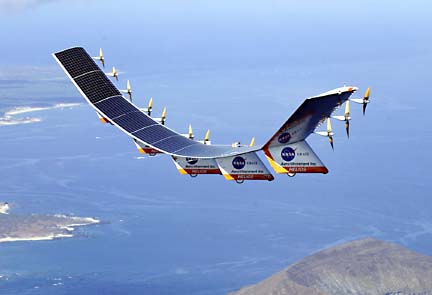
PHOTO COURTESY OF NICK GALANTE
NASA's solar-powered Helios, shown here in a test flight over Niihau and Lehua Rock in 2001, will test new hydrogen fuel cells today in an attempt to build an "eternal airplane."
Solar craft tests
hydrogen power
BARKING SANDS, Kauai >> NASA's giant solar-powered flying wing Helios was scheduled to take off this morning from the Navy's Pacific Missile Range on Kauai on the first test of its new hydrogen fuel cells, which engineers hope will lead to what they call "the eternal airplane."
In August 1991 the unmanned Helios set the world sustained level flight record of 96,863 feet while flying near Kauai. Only rocket-powered aircraft have flown higher.
But in that and similar tests of NASA's Pathfinder and Pathfinder Plus solar planes over Kauai since 1997, all of the aircraft had to be brought down at night because of limited battery capacity.
The new energy cells aboard Helios are designed to allow it to fly at night. Tests scheduled to run through July are aimed at keeping it aloft at least two days and two nights.
The fuel cell system combines hydrogen from two tanks on Helios' outboard wing sections with oxygen from the atmosphere. The two gases are mixed in fuel cells mounted in the aircraft's central landing gear pod to produce more than 15 kilowatts of direct-current electricity for Helios' electric motors. The only byproducts are heat and water vapor.
NASA and Helios' manufacturer, AeroVironment Inc., ultimately hope to produce a solar plane capable of flying above the weather for months, providing many of the services now performed by much more expensive satellites.
Today's scheduled flight was postponed from Thursday because of stormy weather. If it takes off as scheduled and there are no problems, Helios will stay aloft for 20 hours and reach a maximum altitude of 50,000 feet. Takeoff was scheduled for 8:30 a.m. today, with a landing at 4 a.m. tomorrow.
NASA conducted a preliminary test on May 15 at the Pacific Missile Range to determine whether Helios could take off safely with the added weight of the fuel cells. Control of the solar plane during takeoff is by a pilot riding a platform atop a truck rolling behind the aircraft. Once airborne, it is handed off to pilots in the NASA hangar at the base.
Kauai has been the site of all of NASA's solar airplane tests because of its proximity to the equator, the Navy's huge ocean test area and the large runway at the Pacific Missile Range. With a wingspan of 247 feet and several sets of wheels, Helios needs all of the runway and the adjoining tarmac to take off and land.
Previous tests of Helios have been open to the public and drew sizable crowds. This year, because of tighter base security, the tests are not open to the public.
NASA
